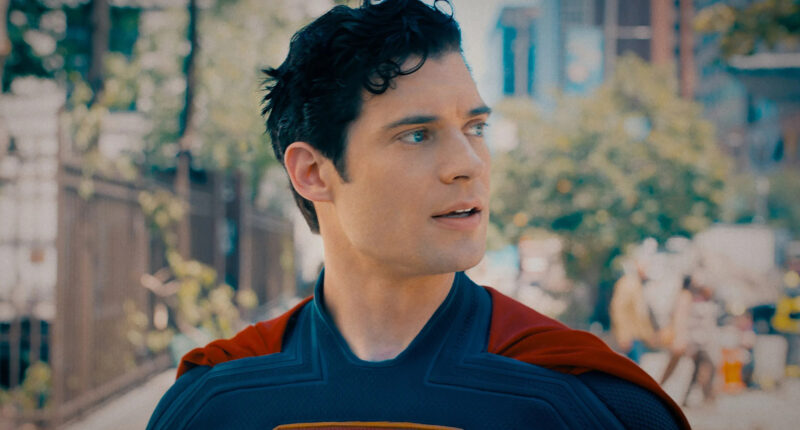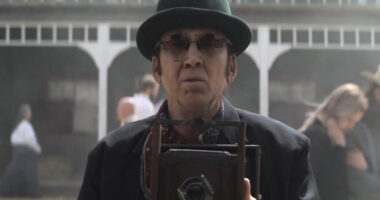Share this @internewscast.com
In 1939, Jerry Siegel and Joe Shuster debut Superman in “Action Comics” #1, revolutionizing popular culture with one of the first-ever superheroes. Over the years, the Man of Steel has been adapted numerous times into various formats, including live-action television series, animated films, and blockbuster movies. His initial screen appearance came less than ten years after his comic book debut, as part of a theatrical serial.
Those early serials portrayed Superman and his universe quite differently compared to today’s interpretations. Over time, movies have become more expansive, daring, and loyal to the original comics. Technological strides in special effects have led audiences to believe in the Man of Steel’s ability to fly. His most recent cinematic rendition, “Superman,” pushes these possibilities even further.
Feeling daunted about where to start on a Superman movie marathon? We have crafted the perfect watch order to guide you through. So when you look up at the sky, remember — it’s not a bird or a plane, but simply the definitive way to experience all the Superman films! (Hint: Following their release order isn’t necessary.)
- “Superman” (2025)
- “Superman: The Motion Picture” (1978)
- “Superman II” (1980)
- “Superman Returns” (2006)
- “Superman III” (1983)
- “Superman IV: The Quest for Peace” (1987)
- “Supergirl” (1984)
- “Man of Steel” (2013)
- “Batman v Superman: Dawn of Justice” (2016)
- “Justice League” (2017)
- “Zack Snyder’s Justice League” (2021)
- The Superman Serials (1948-51)
Why is this the correct order to watch
When you’re diving into a franchise with more than a dozen chapters, especially one that encompasses multiple reboots, restarts, and failed cinematic universes, figuring out where to begin can be a stumbling block. If you’ve never seen a Superman film before, you may be even more perplexed. After all, more than half a dozen actors have played the world’s greatest superhero on the big screen, and they starred in film sagas produced in vastly different cinematic eras. With that in mind, we think our order is the best way to watch the DC hero’s big-screen adventures for today’s fans who may not be completely familiar with the history of Superman on film.
Admittedly, “correct” may be a bit of a hyperbole. Still, the order in which we’re recommending you watch the “Superman” movies is designed with one thing in mind: to maximize your enjoyment of every film in the Man of Steel’s cinematic pantheon because, while not all of the films centered on Superman have been great, all of them have something great about them. It’s just a matter of lining them up in a way that brings their best qualities to the fore and creates a sense of appreciation for even those installments that aren’t very good.
Superman (2025)
It might seem like an odd choice, but we recommend that you watch James Gunn’s “Superman” first, even before Richard Donner’s “Superman: The Motion Picture.” Not because it’s the latest, or even the best, but because even though it’s the most recent one, it’s being lauded for faithfully translating Supes’ comic book adventures to the screen.
Instead of an origin story, “Superman” drops us into a Metropolis where Clark Kent (David Corenswet) has already been serving as the city’s most powerful hero for some time. But he finds himself at odds with the rest of the wider superhero community — and the U.S. government — when he intervenes in a foreign conflict. At the same time, corporate supervillain Lex Luthor (Nicholas Hoult) has created his own superhero to rival Superman, the masked mystery man called Ultraman.
With an eye toward crafting a new cinematic universe, “Superman” makes the bold choice to have the character exist in a world populated by heroes like Green Lantern (Nathan Fillion), Hawkgirl (Isabela Merced), Mr. Terrific (Edi Gathegi), and Metamorpho (Anthony Carrigan). It all comes together to create a colorful backdrop for the quintessential Superman film for the 21st century. There’s no better place to start for novices than the best Superman film in the modern era. That it also features Krypto the Superdog is the icing on the cake.
Superman: The Motion Picture
Now that you’ve seen the best live-action Superman in the modern era, let’s go back in time to 1978 and watch the movie that started it all: “Superman: The Motion Picture.” Despite being almost 50 years old, the superhero film remains influential, frequently cited by filmmakers like James Gunn as an inspiration. It gave us John Williams’ iconic theme and showed audiences that comic books could become movies to entertain everyone, not just kids.
“Superman: The Movie” tells the definitive origin story, with baby Kal-El shot into space from a dying Krypton by his father, Jor-El (Marlon Brando). We see him land in Kansas, we witness his teenage years in Smallville, where he discovers his powers, and we watch him move to Metropolis, where he transforms into a costumed superhero. We also get the cinematic debut of his biggest rival, Lex Luthor (Gene Hackman), while Christopher Reeve gives a performance that every Superman actor since has tried to emulate.
“Superman: The Motion Picture” may seem dated if you grew up on superhero movies from the 2000s. Some parts may even seem silly today. But this is the movie that gave Superman life on the big screen, and it remains one of the best comic book movies ever made.
Superman II
Released in 1980, “Superman II” is a direct continuation of “Superman: The Motion Picture” and sees the return of three Kryptonian villains whom Jor-El banished to another dimension early in that movie. Here, they manage to escape their imprisonment and find themselves on Earth, where, like Superman, they have incredible powers.
As the film begins, Clark Kent declares his love for Lois Lane, and — determined to spend his life with her — he sacrifices his superpowers to become an ordinary man. But when the three Kryptonians, General Zod (Terrance Stamp), Ursa (Sarah Douglas), and Non (Jack O’Halloran), arrive and set out to use their powers to become unquestionable rulers of the planet, Superman realizes that giving up his human life as Clark Kent might be the only way to save the world.
Exploring the sacrifices that true heroes must sometimes make for the greater good, “Superman II” is the rare sequel that’s even better than the original. Especially if you watch the Richard Donner cut, which was reassembled by the legendary director himself and released in 2006.
Superman Returns
After “Superman II,” you might expect us to recommend you watch “Superman III,” but that’s not the case. In 2006, director Bryan Singer revived the franchise with “Superman Returns,” which, surprisingly, took the series back in time and served as a direct follow-up to “Superman II.” Effectively erasing the events of “Superman III” and “Superman IV: The Quest for Peace,” the film sees Brandon Routh, Kate Bosworth, and Kevin Spacey take over the roles of Superman, Lois Lane, and Lex Luthor, respectively.
In “Superman Returns,” Kal-El does just that: he’s spent the past five years in space searching for the location of his home planet of Krypton and comes back to Earth after his outer space quest. But what he finds when he gets back isn’t what he expects, as it seems the world has moved on without him. Lois found love and is engaged to Richard (James Marsden), the nephew of Perry White (Frank Langella), and they’re raising a child together. Meanwhile, Luthor has been released from prison and is back to his old tricks.
While “Superman Returns” is missing a lot of the big action audiences expected, it makes up for it with pathos and human drama. It’s a touching homage to Christopher Reeve’s “Superman” films, with Routh giving a strong performance as the Man of Steel.
Superman III
Despite being the lesser sequel to “Superman II,” 1983’s “Superman III” has its own charms. It suffers mostly from the studio’s desire to turn the franchise into a comedy, evidenced by the presence of comedian Richard Pryor. The legendary Pryor plays Gus Gorman, a computer engineer who is unwittingly swept up in a villain’s scheme to destroy Superman.
That villain is Ross Webster (Robert Vaughn), a wealthy tycoon who aims to take control of the world’s entire oil supply so he can bring governments to their knees. The film also uncovers more of Clark Kent’s backstory, as we meet his high school sweetheart Lana Lang (Annette O’Toole), and the film once again explores Clark’s inner conflict over his life as Superman.
Though it can be overly goofy at times, there’s some good stuff in “Superman III,” including a famous sequence where Superman is split in two, and he must fight an evil version of himself, and the standout climax that sees Webster’s wife transformed into a living computer is equal parts silly and terrifying. Though flawed, the film is a time capsule of ’80s superhero movie fare, and a good example of just how far Superman movies have come.
Superman IV: The Quest For Peace
We’re not going to sugarcoat this one: “Superman IV: The Quest for Peace” is an awful movie. We’re only including it here for fans who want the complete picture of Superman’s adventures on the big screen. Even those involved with the movie regret it, with Christopher Reeve once remarking in his memoir that the film was “a catastrophe from start to finish” and that it seriously hurt his career. With its cheap special effects, oddball characters, and nonsensical plot, it’s easy to see why.
The film almost wasn’t made at all, as Reeve had been uninterested in continuing the franchise. But after being promised it would explore a real social issue — nuclear proliferation — Reeve agreed to return. The villain is once again Lex Luthor, but this time he’s created his own superpowered “hero,” Atom Man, who is designed for the sole purpose of killing Superman once and for all.
Worth watching for completeness’ sake, “Quest for Peace” might also have some value as a “so bad it’s good” movie. And, as the last performance by Christopher Reeve in his most iconic role and Gene Hackman as Lex Luthor, it’s a notable film, even if only for offering a glimpse of what might have been.
Supergirl
In between “Superman III” and “Superman IV: Quest For Peace,” the franchise got a spin-off, “Supergirl,” starring Helen Slater. But there’s no need to watch it in release order, as nothing in the movie has any impact on the other films, and there is only a passing reference made to Superman. Still, it’s an important part of the ’80s Superman saga.
In “Supergirl” we meet the eponymous teen hero, Kara Zor-El, who goes by the name Linda Lee in her human identity. We see her origin on Krypton and how, as a teen, she was able to escape the destruction of her world by entering a pocket dimension. But we also learn that she took a rocket ship to Earth to search for a powerful device created by a Kryptonian wizard named Zaltar (Peter O’Toole). Unfortunately, the device winds up in the hands of Selena (Faye Dunaway), a ruthless Earth sorceress who plans to use it to take control of the planet.
Overly cheesy in its attempt to appeal to little girls and full of camp (and not the good kind), “Supergirl” was an overhyped superhero movie that turned out to be terrible. Still, it’s kind of fun to see such highly respected actors like O’Toole and Dunaway hamming it up.
Man of Steel
After watching “Superman IV: The Quest for Peace” and “Supergirl” back-to-back, you may be sick of the goofiness of ’80s Superman movies. Well, here’s some good news: it’s time to queue up Zack Snyder’s 2013 reboot, “Man of Steel.” With an emphasis on over-the-top action — something sorely missing in previous Superman adventures on the big screen — the film is a roller coaster ride from start to finish, with plenty of pause-worthy moments.
“Man of Steel” reinvents Superman for the 21st century, presenting him as a reluctant hero who has been trying to hide his alien nature. But when the world’s problems become too much and the Kryptonian supervillain Zod arrives, Clark Kent is forced to suit up as Superman to save the planet. Because General Zod (Michael Shannon) has plans to terraform Earth and turn it into a new Krypton, over which he will rule.
With a solid cast led by Henry Cavill as the titular Man of Steel, the film is full of great performances. At its best, “Man of Steel” is a true blockbuster, with impressive action sequences and grandiose special effects. What it lacks in heart, it more than makes up for in comic book spectacle.
Batman v Superman: Dawn of Justice
Following “Man of Steel,” we recommend moving right into its sequel, “Batman v Superman: Dawn of Justice.” Though it was met with harsh reviews and remains divisive among fans, it did exactly what fans had been waiting decades to see, teaming Superman up with the Dark Knight himself. It was all part of a carefully mapped plan to turn the world of DC Comics superheroes into their own cinematic universe, and with an extended appearance from Wonder Woman — and cameos for the Flash and Aquaman — it does just that.
The film introduces Bruce Wayne (Ben Affleck) as a harsh critic of Kal-El, who he doesn’t trust after the Kryptonian destroyed half of Metropolis in his fight with General Zod in “Man of Steel.” Manipulated into thinking Superman is the real villain by devious industrialist Lex Luthor (Jesse Eisenberg), Batman quickly deduces that Kal-El isn’t his enemy. It turns out that Luthor has created his own monstrous doppelganger of the Man of Steel in an attempt to take down Superman, who he sees as a threat to world order.
Even darker and grittier than “Man of Steel,” “Batman v Superman” gives audiences a brutally violent tale that works well in its best moments but is a clunky mess at its worst.
Justice League
It might not be a solo Superman film, but “Justice League” is what the previous two Zack Snyder films were building to, and Kal-El is one of the driving forces behind the team’s story. Controversially, of course, the film was released in two vastly different versions, and we’re recommending you watch the theatrical cut that was finished by Joss Whedon first. It’s a tad clunkier than Snyder’s cut but is presented in a much more appealing widescreen format instead of 4:3 and has a shorter and friendlier runtime.
Superman is dead after the events of “Batman v Superman,” so when an alien tyrant called Steppenwolf arrives on Earth to collect an ancient relic, it forces Batman, Wonder Woman, Aquaman, Flash, and Cyborg to work together to stop him and his army from running rampant across the globe. But they quickly find their combined powers are still no match for Steppenwolf, and, to save the world, they have to find a way to resurrect the Man of Steel.
A mixed bag of disjointed plot beats, overstuffed story, and cardboard characters, “Justice League” went horribly wrong at the box office. Nevertheless, both it and Snyder’s longer version of the film satisfy if you’re looking for some solid superhero team-up action.
The Superman serials
Once you’ve seen every feature-length Superman movie, it’s worth going back in time for some additional viewing. Long before Christopher Reeve — even before the 1952 TV series starring George Reeves — Kirk Alyn played the Man of Steel on the silver screen. Produced as theatrically released shorts that told three stories across 15 parts each, these were Superman’s first-ever live-action adventures.
In 1948, Alyn starred as Clark Kent/Superman in the first 15-part story simply titled “Superman.” With a 244-minute total runtime, the serial explores the entire story of Kal-El, from his escape from Krypton to his upbringing on the Kent farm to his move to Metropolis and his adventures as Superman, where he faces off against a diabolical villain known as The Spider Lady. Two subsequent serials, “Superman and the Atom Men” and “Superman and the Mole Men,” followed in 1950 and 1951.
A true history lesson, the Superman serials had an enormous influence on all that would follow. They might have taken a few liberties with the source material, but they also played a big part in turning the character into a household name.
Is there another way to watch the Superman movies?
Just because we’re recommending you watch the “Superman” movies in a particular order doesn’t mean our preferred chronology is the one you’ll enjoy the most. After all, everyone’s tastes are different. While our recommendation was designed to maximize enjoyment, we were operating under the assumption that you’ve never seen any of them.
That said, if you’re already familiar with Superman’s older movies or just have an existing appreciation for classic cinema, this order might not be best for you. In fact, you may just want to watch them in release order. This would mean popping on the classic serials first, then the Christopher Reeve movies, the Bryan Singer detour, Zack Snyder’s films, and then James Gunn’s newest masterpiece. In that case, the order would be as follows:
- The Superman Serials (1948-51)
- “Superman: The Motion Picture” (1978)
- “Superman II” (1980)
- “Superman III” (1983)
- “Supergirl” (1984)
- “Superman IV: The Quest for Peace” (1987)
- “Superman Returns” (2006)
- “Man of Steel” (2013)
- “Batman v Superman: Dawn of Justice” (2016)
- “Justice League” (2017)
- “Zack Snyder’s Justice League” (2021)
- “Superman” (2025)
Whatever order you decide to watch the Superman movies in, though, just make sure to remember: He’s not a bird, or a plane … he’s just the greatest superhero of all time.








